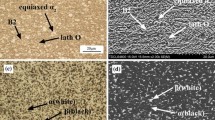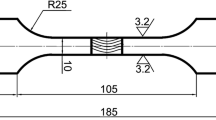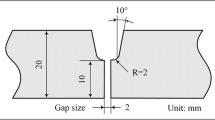Abstract
The mechanical properties of 2060 and 2099 T-joints welded by double-sided laser beam welding were analyzed in this experiment. Various mechanical tests were performed to determine the transverse tensile properties of the region perpendicular to the weld, the tensile properties of the skin and stringer, the compressive properties of the region parallel to the weld seam, and the fatigue properties perpendicular to the weld seam. The T-joint was found to consist of the base metal, partial melting zone, equiaxed zone (EQZ), columnar crystal zone, and cellular dendritic zone from the base metal to the center of the weld seam. The EQZ was proved to be the weak area during mechanical properties tests of the T-joint. Moreover, the welding penetration had a great influence on the transverse tensile properties and weak areas were located in the EQZ near the lower fusion line. The EQZ near the upper fusion line was the weak area in the process of compression. In addition, severe porosities and cracks greatly influenced the mechanical properties of the joint. The fatigue property was closely related to the deformation angle; the fatigue source was located at the weld toe, and the crack propagation was along the base metal.


















Similar content being viewed by others
References
P.F. Mendez and T.W. Eagar, Welding Processes for Aeronautics, Adv. Mater. Process., 2001, 159, p 39–43
W.V. Vaidya, M. Horstmann, E. Seib, K. Toksoy, and M. Koçak, Assessment of Fracture and Fatigue Crack Propagation of Laser Beam and Friction Stir Welded Aluminium and Magnesium Alloys, Adv. Eng. Mater., 2006, 8, p 399–406. https://doi.org/10.1002/adem.200600015
J. Enz, S. Riekehr, V. Ventzke, and N. Kashaev, Influence of the Local Chemical Composition on the Mechanical Properties of Laser Beam Welded Al-Li Alloys, Phys. Procedia, 2012, 39, p 51–58. https://doi.org/10.1016/j.phpro.2012.10.013
R. Wilson, A. Murphy, M.A. Price, and C. Glazebrook, A Preliminary Structural Design Procedure for Laser Beam Welded Airframe Stiffened Panels, Thin Walled Struct., 2012, 55, p 37–50. https://doi.org/10.1016/j.tws.2012.03.003
D. Dittrich, J. Standfuss, J. Liebscher, B. Brenner, and E. Beyer, Laser Beam Welding of Hard to Weld Al Alloys for a Regional Aircraft Fuselage Design—First Results, Phys. Procedia, 2011, 12, p 113–122. https://doi.org/10.1016/j.phpro.2011.03.015
R.J. Rioja and J. Liu, The Evolution of Al-Li Base Products for Aerospace and Space Applications, Metall. Mater. Trans. A Phys. Metall. Mater. Sci., 2012, 43, p 3325–3337. https://doi.org/10.1007/s11661-012-1155-z
L. Ou, Z. Zheng, Y. Nie, and H. Jian, Hot Deformation Behavior of 2060 Alloy, J. Alloys Compd., 2015, 648, p 681–689. https://doi.org/10.1016/j.jallcom.2015.07.027
A.I. Karayan, K. Jata, M. Velez, and H. Castaneda, On Exfoliation Corrosion of Alloy 2060 T8E30 in an Aggressive Acid Environment, J. Alloys Compd., 2016, 657, p 546–558. https://doi.org/10.1016/j.jallcom.2015.10.082
B. Cai, Z.Q. Zheng, D.Q. He, S.C. Li, and H.P. Li, Friction Stir Weld of 2060 Al-Cu-Li Alloy: Microstructure and Mechanical Properties, J. Alloys Compd., 2015, 649, p 19–27. https://doi.org/10.1016/j.jallcom.2015.02.124
H. Li, J. Zou, J. Yao, and H. Peng, The Effect of TIG Welding Techniques on Microstructure, Properties and Porosity of the Welded Joint of 2219 Aluminum Alloy, J. Alloys Compd., 2017, 727, p 531–539. https://doi.org/10.1016/j.jallcom.2017.08.157
J. Zhang, B. Wang, and D. Yi, Stress Corrosion Cracking Behavior in 2297 Al-Cu-Li Alloy at Different Grain Orientations, Mater. Sci. Eng. A, 2019, 764, p 138252. https://doi.org/10.1016/j.msea.2019.138252
Z. Yang, X. Zhao, W. Tao, and C. Jin, Effects of Keyhole Status on Melt Flow and Flow-Induced Porosity Formation during Double-Sided Laser Welding of AA6056/AA6156 Aluminium Alloy T Joint, Opt. Laser Technol., 2019, 109, p 39–48. https://doi.org/10.1016/j.optlastec.2018.07.065
W. Tao, Z. Yang, C. Shi, and D. Dong, Simulating Effects of Welding Speed on Melt Flow and Porosity Formation during Double-Sided Laser Beam Welding of AA6056-T4/AA6156-T6 Aluminum Alloy T-Joint, J. Alloys Compd., 2017, 699, p 638–647. https://doi.org/10.1016/j.jallcom.2016.12.371
Z. Yang, W. Tao, L. Li, Y. Chen, and C. Shi, Numerical Simulation of Heat Transfer and Fluid Flow during Double-Sided Laser Beam Welding of T-Joints for Aluminum Aircraft Fuselage Panels, Opt. Laser Technol., 2017, 91, p 120–129. https://doi.org/10.1016/j.optlastec.2016.12.018
T. Liu, X. Zhan, Y. Zhao, M. Bai, and X. Gong, Study on 2219 Aluminum Alloy T-Joint during Dual Laser-Beam Bilateral Synchronous Welding: Effect of the Welding Speed and Incident Beam Angle on Grain Morphology, Opt. Laser Technol., 2019, 119, p 105594. https://doi.org/10.1016/j.optlastec.2019.105594
Y. Zhao, Y. Wu, M. Chen, Y. Gu, and X. Zhan, Research on the Stripping Performance during Dual Laser-Beam Bilateral Synchronous Welding of 2219 Aluminum Alloy T-Joint for Spacecraft, J. Manuf. Process., 2019, 45, p 33–45. https://doi.org/10.1016/j.jmapro.2019.06.024
W. Tao, Z. Yang, Y. Chen, L. Li, Z. Jiang, and Y. Zhang, Double-Sided Fiber Laser Beam Welding Process of T-Joints for Aluminum Aircraft Fuselage Panels: Filler Wire Melting Behavior, Process Stability, and Their Effects on Porosity Defects, Opt. Laser Technol., 2013, 52, p 1–9. https://doi.org/10.1016/j.optlastec.2013.04.003
Z.B. Yang, W. Tao, L.Q. Li, Y.B. Chen, F.Z. Li, and Y.L. Zhang, Double-Sided Laser Beam Welded T-Joints for Aluminum Aircraft Fuselage Panels: Process, Microstructure, and Mechanical Properties, Mater. Des., 2012, 33, p 652–658. https://doi.org/10.1016/j.matdes.2011.07.059
X. Zhan, J. Chen, J. Liu, Y. Wei, J. Zhou, and Y. Meng, Microstructure and Magnesium Burning Loss Behavior of AA6061 Electron Beam Welding Joints, Mater. Des., 2016, 99, p 449–458. https://doi.org/10.1016/j.matdes.2016.03.058
B. Han, Y. Chen, W. Tao et al., Nano-indentation Investigation on the Local Softening of Equiaxed Zone in 2060-T8/2099-T83 Aluminum-Lithium Alloys T-Joints Welded by Double-Sided Laser Beam Welding, J. Alloys Compd., 2018, 756, p 145–162. https://doi.org/10.1016/j.jallcom.2018.05.014
X. Chen, Z. Lei, Y. Chen et al., Nano-indentation and In Situ Investigations of Double-Sided Laser Beam Welded 2060-T8/2099-T83 Al-Li Alloys T-Joints, Mater. Sci. Eng. A, 2019, 756, p 291–301. https://doi.org/10.1016/j.msea.2019.04.066
H. Liu, S. Yang, C. Xie, Q. Zhang, and Y. Cao, Microstructure Characterization and Mechanism of Fatigue Crack Initiation Near Pores for 6005A CMT Welded Joint, Mater. Sci. Eng. A, 2017, 707, p 22–29. https://doi.org/10.1016/j.msea.2017.09.029
C. Shao, H. Cui, F. Lu, and Z. Li, Quantitative Relationship Between Weld Defect Characteristic and Fatigue Crack Initiation Life for High-Cycle Fatigue Property, Int. J. Fatigue, 2019, 123, p 238–247. https://doi.org/10.1016/j.ijfatigue.2019.02.028
P.I. Oliveira, F.V. Antunes, A. Loureiro, and J.M. Costa, Effect of the Angular Misalignment of Laser Welded T-Joints on Fatigue Curves, Int. J. Fatigue, 2019, 128, p 105180. https://doi.org/10.1016/j.ijfatigue.2019.06.040
Acknowledgments
This research was supported by Natural Science Foundation of China (51605276, 51905333), Shanghai Sailing Program (19YF1418100), Shanghai Science and Technology Committee Innovation Grant (17JC1400600, 17JC1400601, 19511106400, 19511106402), Karamay Science and Technology Major Project (2018ZD002B), Aid for Xinjiang Science and Technology Project (2019E0235), Shanghai Local Colleges and Universities Capacity Building Special Plan Project (19030501300), Zhejiang Key Project of Research and Development Plan (2019C01114), and the Talent Program of Shanghai University of Engineering Science.
Author information
Authors and Affiliations
Corresponding authors
Additional information
Publisher's Note
Springer Nature remains neutral with regard to jurisdictional claims in published maps and institutional affiliations.
Rights and permissions
About this article
Cite this article
Tan, J., Liu, H., Zhang, P. et al. A Study on the 2060-T8/2099-T83 Aluminum-Lithium Alloys T-Joints Welded by Double-Sided Laser Beam Welding. J. of Materi Eng and Perform 29, 4295–4309 (2020). https://doi.org/10.1007/s11665-020-04967-8
Received:
Revised:
Published:
Issue Date:
DOI: https://doi.org/10.1007/s11665-020-04967-8




